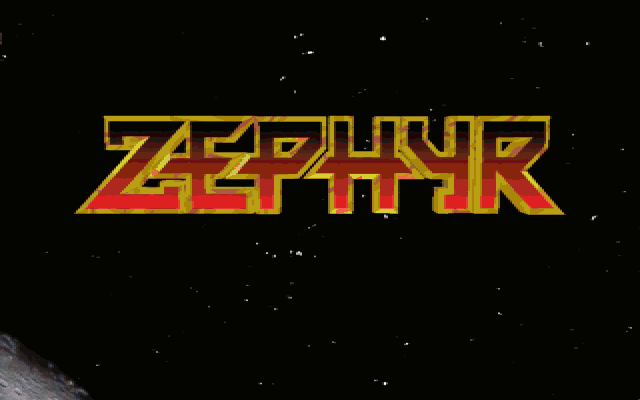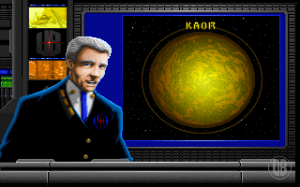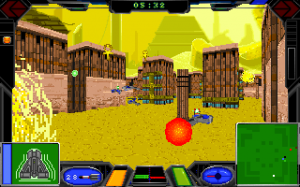Zephyr 


If there’s one concept that games have mastered, it’s the futuristic blood sport. Sure, movies like The Running Man came first, but Smash TV, MadWorld, and their ilk turned those fantasy game shows interactive and pretty much left nowhere else to go. Just don’t tell that to Zephyr.
Designed by the team behind the Might and Magic series, Zephyr nails the hubbub of a gleefully televised cavalcade of murder. Nearly every second features a fictional sponsor, a cheesy commentator, and 90s electronic rock music. The ultraviolent vision is top-to-bottom perfect – including the bits where the rookies needlessly, endlessly die.
In the 24th Century, Earth’s overpopulation drives humanity to a grim, nomadic existence at fringes of space in search of resources. Gigantic super-corporations have become de facto governments, and their battles over unclaimed worlds are the stuff of media ratings booms. The exploitation has reached its logical extreme, with war formally replaced by televised deathmatches on the Interplanetary Battle Circuit. The corporations sponsor Zephrys – futuristic combat vehicles – to fly through cities and countrysides, blowing each other up in high-stakes races for entertainment and profit. You are a newcomer Zephyr pilot, hoping to climb to the top of the ranks.
The illusion is seamless. No game puts the player in the seat of a risk-taking supersport jockey so successfully. Every battle is bookended with commentary from smarmy television hosts and intergalactic celebrities. The sponsor companies vie for your team with bonus equipment before each match; their ads are plastered everywhere, even during the battles. If you get shot down, your team heckles you.
It helps that Zephyr knows its influences. The aesthetics are ripped straight from Paul Verhoeven’s school of dystopian media, complete with an Omni Consumer Products ripoff and hollow, bleakly commercialized TV shows. The sleek corporate self-aggrandizement powerfully contrasts with the apocalyptic conditions of the battle arenas. And the cast list from Top Gun is included among the preselected “callsigns” for your character. The game’s tongue could not be further into its cheek without sticking through the other side, and it makes its brethren look like half-rate homages by comparison.
Notice that I haven’t mentioned the actual gameplay. This is the disappointing catch.
The game’s high-energy shoot-em-up combat is loosely based on Doom, but with a single essential twist: Zephyrs can hover. Players now have to worry about their vertical position. That should work, but it comes with all the baggage and archaic design flaws of old-school shooters. You can’t look up or down, and there’s no autoaim. On far too many occasions, an enemy will pass slightly overhead and out of range.
Adding another degree of freedom to controls is always a risky proposition – especially when this game has choppy movement and no gamepad support – but even on the lower difficulties, the AI has no trouble navigating the skies with impressive precision. Their skills put you on the permanent defensive. Even accounting for the difficulty curve, that’s an insurmountable skill gap. With luck, you might take down one or two enemy Zephyrs per match, usually when they run out of fuel or get stuck in a narrow passage.
Expect to die. A lot.
And those deaths will be harsh and slow. Individual parts of your ship give out fairly easily, including your quickly depleted fuel and ammo reserves. Losing one part pulls you out of the match long enough to scratch any chances of catching up. This isn’t a great idea for an arena deathmatch game. Zephyr offers other ways to score, such as taking out dummy enemies and completing laps around the course, but they don’t count enough to secure victory by themselves. Oftentimes, when you’re lost in a mess of non-opponent hazards and obstructions, the AI will just fight themselves and remove you from the equation entirely.
Zephyr‘s busy visuals add to the disorientation. Given how much is on screen at once – powerups, enemies, ads, decoys, bullets, etc. – and the colorful detail New World Computing put into the environments, it can be difficult to distinguish objects from a distance. This is kind of a problem during intense firefights or (more likely) when trying to sift through the noise to find enemies. This heightens the other shortcomings. It’s a shame that the game’s technical achievements somehow work against its playability. Even the low-detail mode is a mess.
That may be Zephyr‘s problem. The presentation and audio-visuals are top notch to the point where everything else suffers by comparison. Hard games aren’t a problem, but given the enormous disparity between the slick television interludes and the chaotically clunky Doom-in-a-blender mechanics, a little forgiveness would’ve been greatly appreciated. But then again, what part of “blood sport” was ever easy?




You’re making me want to shamelessly clone the atmosphere just so I can throw it into an engine that’s tried and true. I LOVE games that have this sort of atmosphere. Even Fight Night Round 3 kinda got me with the built in advertising (which I’m actually kinda against when it’s real product placement…) so to have a fantasy world I can get COMPLETELY lost in… hey, maybe that’s what drew me to places like Second Life and Minecraft. Anyway, more dystopian company run cyberfutures!